.
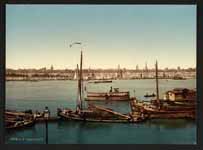
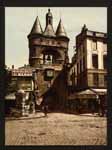
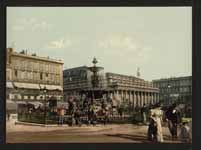
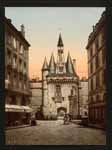
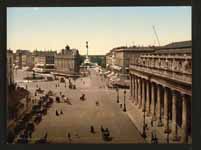
7, 8, 9, 10, 11, 12, 13, 14, 15,
Bordeaux
Bordeaux (French pronunciation: [bɔʁdo]; Gascon: Bordèu; Basque: Bordele) is a port city on the Garonne River in the Gironde department in southwestern France.
The Bordeaux metropolitan area has a population of 1,105,000 and constitutes the sixth-largest urban area in France. It is the capital of the Aquitaine region, as well as the prefecture of the Gironde department. Its inhabitants are called Bordelais.
Bordeaux is the world's major wine industry capital. It is home to the world's main wine fair, Vinexpo,[1] while the wine economy in the metro area moves 14.5 billion euros each year.[2] Bordeaux wine has been produced in the region since the 8th century. The historic part of the city is on the UNESCO World Heritage List as "an outstanding urban and architectural ensemble" of the 18th century.[3]
History
Bordeaux, Port of the Moon *
UNESCO World Heritage Site
Country France
Type Cultural
Criteria ii, iv
Reference 1256
Region ** Europe and North America
Inscription history
Inscription 2007 (31st Session)
* Name as inscribed on World Heritage List
** Region as classified by UNESCO
Coins of the Bituriges Vivisci, 5th–1st century BC, derived from the coin designs of Greeks in pre-Roman Gaul. Cabinet des Médailles.
Between 30,000 and 20,000 years ago the area of Bordeaux was inhabited by the Neanderthal, whose remains have been found at a famous cave known as Pair-non-Pair, near Bourg sur Gironde, just north of Bordeaux. In historical times, around 300 BC it was the settlement of a Celtic tribe, the Bituriges Vivisci, who named the town Burdigala, probably of Aquitainian origin. The name Bourde is still the name of a river south of the city.
The city fell under Roman rule around 60 BC, its importance lying in the commerce of tin and lead towards Rome. Later it became capital of Roman Aquitaine, flourishing especially during the Severan dynasty (3rd century). In 276 it was sacked by the Vandals. Further ravage was brought by the same Vandals in 409, the Visigoths in 414 and the Franks in 498, beginning a period of obscurity for the city.
Merovingian tremisses minted in Bordeaux by the Church of Saint-Étienne, late 6th century. British Museum.
In the late 6th century, the city re-emerged as the seat of a county and an archdiocese within the Merovingian kingdom of the Franks, but royal Frankish power was never strong. The city started to play a regional role as a major urban centre on the fringes of the newly founded Frankish Duchy of Vasconia.
The city was plundered by the troops of Abd er Rahman in 732, after he had defeated Duke Eudes in the Battle of the River Garonne near Bordeaux and before the former was killed during the Battle of Tours on 10 October. After Duke Eudes's defeat, Aquitaine pledged allegiance formally to the new rising Carolingian dynasty, but still remained out of Frankish central rule until 768 (Duke Waifer defeated). In 736, the Aquitanian duke Hunald led a rebellion after his father Eudes's death, at which Charles responded by sending an expedition that captured Bordeaux, while the Frankish commander didn't retain it for long, since he left south-east to wage war in Narbonnaise.
In 778, Seguin (or Sihimin) was appointed count of Bordeaux, probably undermining the power of the Duke Lupo, and possibly leading to the Battle of Roncevaux Pass that very year. In 814, Seguin was made Duke of Vasconia, but he was deposed in 816 for failing to suppress or sympathise with a Basque rebellion. Under the Carolingians, sometimes the Counts of Bordeaux held the title concomitantly with that of Duke of Vasconia. They were meant to keep in check the Basques and defend the mouth of the Garonne from the Vikings when the latter appeared c. 844 in the region of Bordeaux. In Autumn 845, count Seguin II marched on the Vikings assaulting Bordeaux and Saintes but was captured and put to death. There are no bishops mentioned during the whole 8th century and part of the 9th in Bordeaux.
From the 12th to the 15th century, Bordeaux regained importance following the marriage of Duchess Eleanor of Aquitaine with the French-speaking Count Henri Plantagenet, born in Le Mans, who became, within months of their wedding, King Henry II of England. The city flourished, primarily due to wine trade, and the cathedral of St. André was built. It was also the capital of an independent state under Edward, the Black Prince (1362–1372), but in the end, after the Battle of Castillon (1453) it was annexed by France which extended its territory. The Château Trompette (Trumpet Castle) and the Fort du Hâ, built by Charles VII of France, were the symbols of the new domination, which however deprived the city of its richness by halting the wine commerce with England.
In 1462, Bordeaux obtained a parliament, but regained importance only in the 16th century when it became the center of the distribution of sugar and slaves from the West Indies along with the traditional wine.[4]
Bordeaux adhered to the Fronde, being effectively annexed to the Kingdom of France only in 1653, when the army of Louis XIV entered the city.
Edouard Manet: Harbour at Bordeaux, 1871
The 18th century was the golden age of Bordeaux. Many downtown buildings (about 5,000), including those on the quays, are from this period. Victor Hugo found the town so beautiful he once said: "take Versailles, add Antwerp, and you have Bordeaux". Baron Haussmann, a long-time prefect of Bordeaux, used Bordeaux's 18th century big-scale rebuilding as a model when he was asked by Emperor Napoleon III to transform a then still quasi-medieval Paris into a "modern" capital that would make France proud.
The French government relocated from Paris to Bordeaux very briefly during World War II, when it became apparent that Paris would soon fall into German hands (as in 1870 during war against Prussia and at the beginning of World War I). The French capital was soon moved again to Vichy.
From 1940 to 1943, the Italian Royal Navy (Regia Marina Italiana) established BETASOM, a submarine base at Bordeaux. Italian submarines participated in the Battle of the Atlantic from this base which was also a major base for German U-boats as headquarters of 12th U-boat Flotilla. The massive, reinforced concrete U-boat pens have proved impractical to demolish and are now partly used as a cultural centre for exhibitions.
Geography
Bordeaux is located close to the European Atlantic coast, in the southwest of France and in the north of the Aquitaine region. It is around 500 km (310 mi) southwest of Paris. The city is built on a bend of the river Garonne, and is divided into two parts: the right bank to the east and left bank in the west. Historically, the left bank is more developed. In Bordeaux, the Garonne River is accessible to ocean liners. The left bank of the Garonne is a low-lying, often marshy plain.
Climate
Bordeaux's climate is usually classified as an oceanic climate (Köppen climate classification Cfb); however, the summers tend to be warmer and the winters milder than most areas of similar classification. Substantial summer rainfall prevents its climate from being classified as Mediterranean.
Winters are mild because of the prevalence of westerly winds from the Atlantic. Summers are warm and long due to the influence from the Bay of Biscay (surface temperature reaches 21 to 22 °C (70 to 72 °F). The average seasonal winter temperature is 6.53 °C (43.75 °F), but recent winters have been warmer than this. Frosts in the winter are commonplace, occurring several times during a winter, but snowfall is very rare, occurring only once every three years. The average summer seasonal temperature is 19.51 °C (67.12 °F), but every summer in the decade beginning 2001 has exceeded this average. The summer of 2003 set a record with an average temperature of 23.3 °C (73.9 °F).[5]
| Climate data for Bordeaux-Mérignac (1971–2000) | |||||||||||||
|---|---|---|---|---|---|---|---|---|---|---|---|---|---|
| Month | Jan | Feb | Mar | Apr | May | Jun | Jul | Aug | Sep | Oct | Nov | Dec | Year |
| Average high °C (°F) | 10.0 (50.0) |
11.7 (53.1) |
14.5 (58.1) |
16.5 (61.7) |
20.5 (68.9) |
23.5 (74.3) |
26.4 (79.5) |
26.6 (79.9) |
23.7 (74.7) |
18.8 (65.8) |
13.4 (56.1) |
10.7 (51.3) |
18.1 (64.6) |
| Daily mean °C (°F) | 6.4 (43.5) |
7.6 (45.7) |
9.6 (49.3) |
11.6 (52.9) |
15.4 (59.7) |
18.3 (64.9) |
20.8 (69.4) |
20.9 (69.6) |
18.1 (64.6) |
14.2 (57.6) |
9.4 (48.9) |
7.3 (45.1) |
13.3 (55.9) |
| Average low °C (°F) | 2.8 (37.0) |
3.4 (38.1) |
4.6 (40.3) |
6.6 (43.9) |
10.3 (50.5) |
13.0 (55.4) |
15.1 (59.2) |
15.2 (59.4) |
12.5 (54.5) |
9.5 (49.1) |
5.5 (41.9) |
3.8 (38.8) |
8.5 (47.3) |
| Precipitation mm (inches) | 92 (3.62) |
83 (3.27) |
70 (2.76) |
80 (3.15) |
84 (3.31) |
64 (2.52) |
55 (2.17) |
60 (2.36) |
90 (3.54) |
94 (3.7) |
107 (4.21) |
107 (4.21) |
984.2 (38.748) |
| Avg. precipitation days | 12.5 | 11.3 | 11.2 | 12.0 | 11.5 | 8.9 | 7.0 | 7.8 | 9.6 | 11.3 | 12.5 | 12.6 | 128.2 |
| Mean monthly sunshine hours | 107 | 114 | 180 | 177 | 222 | 225 | 243 | 243 | 183 | 134 | 91 | 72 | 1,992 |
| Source: Météo France | |||||||||||||
Economy
Wine
Sauternes vineyard
Main article: Bordeaux wine
Bordeaux has about 116,160 hectares (287,000 acres) of vineyards, 57 appellations, 10,000 wine-producing châteaux and 13,000 grape growers. With an annual production of approximately 960 million bottles,[6] Bordeaux produces large quantities of everyday wine as well as some of the most expensive wines in the world. Included among the latter are the area's five premier cru (first growth) red wines (four from Médoc and one, Château Haut-Brion, from Graves), established by the Bordeaux Wine Official Classification of 1855: The first growths are:
Château Lafite-Rothschild
Château Margaux
Château Latour
Château Haut-Brion
Château Mouton-Rothschild*
*In 1855 Mouton-Rothschild was ranked a Second Growth. In 1973, it was elevated to First Growth status.[7]
Both red and white wines are made in Bordeaux. Red Bordeaux is called claret in the United Kingdom. Red wines are generally made from a blend of grapes, and may be made from Cabernet Sauvignon, Merlot, Cabernet Franc, Petit verdot, Malbec, and, less commonly in recent years, Carménère. White Bordeaux is made from Sauvignon blanc, Sémillon, and Muscadelle. Sauternes is a subregion of Graves known for its intensely sweet, white, dessert wines such as Château d'Yquem.
Because of a wine glut (wine lake) in the generic production, the price squeeze induced by an increasingly strong international competition, and vine pull schemes, the number of growers has recently dropped from 14,000 and the area under vine has also decreased significantly. In the meanwhile however, the global demand for the first growths and the most famous labels markedly increased and their prices skyrocketed.
Others
The Laser Mégajoule will be one of the most powerful lasers in the world, allowing fundamental research and the development of the laser and plasma technologies. This project, carried by the French Ministry of Defence, involves an investment of 2 billion euros. The "Road of the lasers", a major project of regional planning, promotes regional investment in optical and laser related industries leading to the Bordeaux area having the most important concentration of optical and laser expertise in Europe.
20,000 people work for the aeronautic industry in Bordeaux. The city has some of the biggest companies including Dassault, EADS Sogerma, Snecma, Thales, SNPE, and others. The Dassault Falcon private jets are built there as well as the military aircraft Rafale and Mirage 2000, the Airbus A380 cockpit, the boosters of Ariane 5, and the M51 SLBM missile.
Tourism is a major industry, especially concerning wine-making.
Access to the port from the Atlantic ocean is via the Gironde estuary. Almost 9 million tons of goods arrive and leave each year.
Major companies
This list includes both companies based
Arena
CDiscount
Dassault
EADS composites
EADS Sogerma
EADS Space Transportation
Lectra
LU
Marie Brizard
McKesson Corporation
Oxbow
Ricard
Sanofi Aventis
SMURFIT
SNECMA
SNPE
Solectron
Thales Group
William Pitters
Population
In the 1999 census, there were 215,363 inhabitants in the city (commune) of Bordeaux. The 2005 census showed a significant increase, as this figure reached 230,600 inhabitants. The majority of the population is French, but there are sizable groups of Italians, Spaniards (Up to 20% of the Bordeaux population claim some degree of Spanish heritage), Portuguese, Turks, Germans and North Africans.[citation needed]. The built-up area has grown swiftly in recent years with urban sprawl.
| 1793 | 1800 | 1806 | 1821 | 1831 | 1836 | 1841 | 1846 | 1851 |
|---|---|---|---|---|---|---|---|---|
| 104,676 | 91,652 | 92,219 | 89,202 | 99,062 | 98,705 | 104,686 | 125,520 | 130,927 |
| 1856 | 1861 | 1866 | 1872 | 1876 | 1881 | 1886 | 1891 | 1896 |
|---|---|---|---|---|---|---|---|---|
| 149,928 | 162,750 | 194,241 | 194,055 | 215,140 | 221,305 | 240,582 | 252,415 | 256,906 |
| 1901 | 1906 | 1911 | 1921 | 1926 | 1931 | 1936 | 1946 | 1954 |
|---|---|---|---|---|---|---|---|---|
| 256,638 | 251,947 | 261,678 | 267,409 | 256,026 | 262,990 | 258,348 | 253,751 | 257,946 |
| 1962 | 1968 | 1975 | 1982 | 1990 | 1999 | 2006 | 2008 | - |
|---|---|---|---|---|---|---|---|---|
| 249,688 | 266,662 | 223,131 | 208,159 | 210,336 | 215,374 | 232,260 | 235,891 | - |
| Sources : database Cassini of EHESS for selected numbers until 1962[8], database Insee from 1968 (population without double counting and municipal population from 2006)[9] · [10] |
Histogram on demographic change
|
|
||||||||||||||||||||||||||||||||||||||||||||||||||||||||||||||||||||||||||||||||||||||||||||||||||||||||||||||||||||||||||||||||||||||||||||||||||||||||||||||||||||||||||||||||||||||||
|
|||||||||||||||||||||||||||||||||||||||||||||||||||||||||||||||||||||||||||||||||||||||||||||||||||||||||||||||||||||||||||||||||||||||||||||||||||||||||||||||||||||||||||||||||||||||||
Education
University
Main article: University of Bordeaux
The university was created by the archbishop Pey Berland in 1441 and was abolished in 1793, during the French Revolution, before reappearing in 1808 with Napoleon I. Bordeaux accommodates approximately 70,000 students on one of the largest campuses of Europe (235 ha). The University of Bordeaux is divided into four:
The University Bordeaux 1 (Physical sciences and Technologies), 10,693 students in 2002
The University Bordeaux 2 (Medicine and Life sciences), 15,038 students in 2002
The University Bordeaux 3 (Liberal Arts, Humanities, Languages, History), 14,785 students in 2002
The University Bordeaux 4 (Law, Economy and Management). 12,556 students in 2002
Schools
Bordeaux has numerous public and private schools offering undergraduate and postgraduate programs.
Engineering schools:
École nationale supérieure d'arts et métiers
École d'ingénieurs en modélisation mathématique et mécanique
École nationale supérieure d'électronique, informatique, radiocommunications de Bordeaux
École supérieure de technologie des biomolécules de Bordeaux
École nationale d'ingénieurs des travaux agricoles de Bordeaux
École nationale supérieure de chimie et physique de Bordeaux
École pour l'informatique et les nouvelles technologies
Institut des sciences et techniques des aliments de Bordeaux
Institut de cognitique
École supérieure d'informatique
École privée des sciences informatiques
Business and management schools:
IUT Techniques de Commercialisation of Bordeaux (Business School)
Bordeaux école de management (Bordeaux Management School)
EBP International
E-Artsup
Institut des hautes études économiques et commerciales (INSEEC)
Institut supérieur européen de gestion group
Institut supérieur européen de formation par l'action
École de commerce européenne
Other:
Institut d'études politiques de Bordeaux (Institute of political sciences)
École nationale de la magistrature (National school for Magistrate)
École du service de santé des armées
École d'architecture et de paysage de Bordeaux
École des beaux-arts de Bordeaux
École française des attachés de presse et des professionels de la communication (EFAP)
Conservatoire national des arts et métiers d'Aquitaine (CNAM)
Main sights
Place de la Bourse
The church of St Pierre
Façade of the Church of the Holy Cross
Grand Théâtre
Place de la Bourse at night with the Miroir d'eau and tram
Rue Sainte-Catherine
Church of Notre Dame
Bordeaux is classified "City of Art and History". The city is home to 362 monuments historiques (only Paris has more in France) with some buldings dating back to roman times. Bordeaux has been inscribed on UNESCO World Heritage List as "an outstanding urban and architectural ensemble".
Bordeaux is home to one of Europe's biggest 18th century architectural urban areas, making it a sought-after destination for tourists and cinema production crews. It stands out as one of the first French cities, after Nancy, to have entered an era of urbanism and metropolitan big scale projects, with the team Gabriel father and son, architects for King Louis XV, under the supervision of two intendants (Governors), first Nicolas-François Dupré de Saint-Maur then the Marquis (Marquess) de Tourny.
Buildings
Main sights include:
Esplanade des Quinconces, one of the largest squares in France.
Colonnes des Girondins
Grand Théâtre, a large neoclassical theater built in the 18th century.
Allées de Tourny
Cours de l'Intendance
Place du Chapelet
Place de la Bourse(1730–1775), designed by the Royal architect Jacques Ange Gabriel as landscape for an equestrian statue of Louis XV.
Place du Parlement
Place Saint-Pierre
Pont de pierre
Saint-André Cathedral, consecrated by Pope Urban II in 1096. Of the Original Romanesque edifice only a wall in the nave remain. The Royal Gate is from the early 13th century, while the rest of the construction is mostly from the 14th–15th centuries.
Tour Pey-Berland (1440–1450), a massive, quadrangular gothic tower annexed to the cathedral.
Église Sainte-Croix (Church of the Holy Cross). It lies on the site of a 7th century abbey destroyed by the Saracens. Rebuilt under the Carolingians, it was again destroyed by the Normans in 845 and 864. It is annexed to a Benedictine abbey founded in the 7th century, and was built in the late 11th-early 12th centuries. The façade is in Romanesque style
The gothic Basilica of Saint Michael, constructed in the late 14th–15th centuries.
Basilica of Saint-Seurin, the most ancient church in Bordeaux. It was built in the early 6th century on the site of a palaeochristian necropolis. It has an 11th century portico, while the apse and transept are from the following century. The 13th century nave has chapels from the 11th and the 14th centuries. The ancient crypt houses sepulchres of the Merovingian family.
Église Saint-Pierre, gothic church
Église Saint-Éloi, gothic church
Église Saint-Bruno, baroque church decorated with frescoes
Église Notre-Dame, baroque church
Église Saint-Paul-Saint-François-Xavier, baroque church
Palais Rohan (Exterior:[11])
Palais Gallien, the remains of a late 2nd century Roman amphitheatre
Porte Cailhau, a medieval gate of the old city walls.
La Grosse Cloche (15th century), the second remaining gate of the Medieval walls. It was the belfry of the old Town Hall. It consists of two 40 m-high circular towers and a central bell tower housing a bell weighing 7,800 kilograms (17,000 lb). The watch is from 1759.
Rue Sainte-Catherine, the longest and busiest street in the old town of Bordeaux.
The BETASOM submarine base
Saint-André Cathedral, Saint-Michel Basilica and Saint-Seurin Basilica are part of the World Heritage Sites of the Routes of Santiago de Compostela in France.
Contemporary architecture
Fire Station, la Benauge, Claude Ferret/Adrien Courtois/Yves Salier, 1951–1954
Court of first instance, Richard Rogers, 1998
CTBA, wood and furniture research centre, A. Loisier, 1998
Hangar 14 on the Quai des Chartrons, 1999
The Management Science faculty on the Bastide, Anne Lacaton/Jean-Philippe Vassal, 2006
The Jardin botanique de la Bastide, Catherine Mosbach/Françoise Hélène Jourda/Pascal Convert, 2007
The Nuyens School complex on the Bastide, Yves Ballot/Nathalie Franck, 2007
Seeko'o Hotel on the Quai des Chartrons, King Kong architects, 2007
Museums
Musée des Beaux Arts (Fine arts museum), one of the finest painting galleries in France with paintings by painter such as Tiziano, Veronese, Rubens, Van Dyck, Frans Hals, Claude, Chardin, Delacroix, Renoir, Seurat, Matisse and Picasso.
Musée d'Aquitaine (archeological and history museum)
Musée du Vin et du Négoce (museum of the wine trade)
Musée des Arts Décoratifs (museum of decorative arts)
Musée d'Histoire Naturelle (natural history museum)
Centre d'arts plastiques contemporains (CAPC) (contemporary art museum)
Musée National des Douanes
Vinorama
Musée Goupil
Casa de Goya
Cap Sciences
Centre Jean Moulin
Parks and gardens
Jardin botanique de Bordeaux
Jardin botanique de la Bastide
La Maison des Chameaux (Camel Park)
Shopping
Bordeaux has many shopping options. In the heart of Bordeaux is Rue Sainte-Catherine. This pedestrian only shopping street has 1.2 kilometres (0.75 mi) of shops, restaurants and cafés; it is also one of the longest shopping streets in Europe. Rue Sainte-Catherine starts at Place de la Victoire and ends at Place de la Comédie by the Grand Théâtre. The shops become progressively more upmarket as one moves towards Place de la Comédie and the nearby Cours de l'Intendance is where one finds the more exclusive shops and boutiques.
Culture
Bordeaux is also the first city in France to have created, in the 1980s, an architecture exhibition and research centre, Arc en rêve, still the most prestigious in France besides Paris IFA. Bordeaux offers a large number of cinemas, theatres and is the home of the Opéra national de Bordeaux. There are many music venues of varying capacity. The city also offers several festivals throughout the year.
Transport
Road
Bordeaux is an important road and motorway junction. The city is connected to Paris by the A10 motorway, with Lyon by the A89, with Toulouse by the A62, and with Spain by the A63. There is a 45 km (28 mi) ring road called the "Rocade" which is often very busy. Another ring road is under consideration.
Pont-de-Pierre
Bordeaux has four road bridges that cross the Garonne, the Pont de pierre built in the 1820s and three modern bridges built after 1960: the Pont Saint Jean, just south of the Pont de pierre (both located downtown), the Pont d'Aquitaine, a suspended bridge downstream from downtown, and the Pont François Mitterrand, located upstream of downtown. These two bridges are part of the ring road around Bordeaux. There is also a railway bridge, completed in 2008.
Rail
The main railway station, Gare de Bordeaux Saint-Jean, near the centre of the city, has 4 million passengers a year. It is served by the French national (SNCF) railway's high speed train, the TGV, that gets to Paris in three hours, with connections to major European centres such as Lille, Brussels, Amsterdam, Cologne, Geneva and London. The TGV also serves Toulouse and Irun from Bordeaux. A regular train service is provided to Nantes, Nice, Marseille and Lyon. The Gare Saint-Jean is the major hub for regional trains (TER) operated by the SNCF to Arcachon, Limoges, Agen, Périgueux, Pau and Bayonne.
Historically the train line used to terminate at a station on the right bank of the river Garonne near the Pont de Pierre, and passengers crossed the bridge to get into the city. Subsequently a single track steel railway bridge was constructed in the 1850s, by Gustave Eiffel, to bring trains across the river direct into Gare de Bordeaux Saint-Jean. The old station was later converted and in 2010 comprised a cinema and restaurants.
The single track Eiffel bridge became a bottleneck and a new bridge was built, opening in 2008(??). During the planning there was much lobbying by the Eiffel family and other supporters to preserve the old bridge as a footbridge across the Garonne, with possibly a museum to document the history of the bridge and Gustav Eiffel's contribution. The decision was taken to save the bridge, but by early 2010 no plans had been announced as to its future use. The bridge remains intact, but unused and without any means of access.
Air
Bordeaux is served by an international airport, Aéroport de Bordeaux Mérignac, located 8 km (5.0 mi) from the city centre in the suburban city of Mérignac.
Trams, buses and boats
Bordeaux has an important public transport system called Tram et Bus de la CUB (TBC). This company is run by the Keolis group. The network consists of:
3 tram lines (A, B and C)
75 bus routes, all connected to the tramway network (from 1 to 96)
13 night bus routes (from 1 to 16)
An electric bus shuttle in the city centre
A boat shuttle on the Garonne river
This network is operated from 5 am to 1 am.
There had been several plans for a subway network to be set up, but they stalled for both geological and financial reasons. Work on the Tramway de Bordeaux system was started in the autumn of 2000, and services started in December 2003 connecting Bordeaux with its suburban areas. The tram system uses ground-level power supply technology (APS), a new cable-free technology developed by French company Alstom and designed to preserve the aesthetic environment by eliminating overhead cables in the historic city. Conventional overhead cables are used outside the city. The system was controversial for its considerable cost of installation, maintenance and also for the numerous initial technical problems that paralysed the network. Many streets and squares along the tramway route became pedestrian areas, with limited access for cars.
Taxi
There are more than 400 taxicabs in Bordeaux.
Sport
Girondins de Bordeaux club crest
The Stade Chaban-Delmas is the largest stadium. It can host 35000 spectators. There are two major sport teams in Bordeaux:
Girondins de Bordeaux is the football team. It is part of the Ligue 1 in the French football championship.
Union Bordeaux Bègles is the rugby team. It is part of the Top 14 in the Ligue Nationale de Rugby.
Bordeaux is the home of one of the strongest cricket teams in France and are the current champions of the South West League.
There is a 250 m (820 ft) wooden velodrome, Vélodrome du Lac, in Bordeaux which hosts international cycling competition in the form of UCI Track Cycling World Cup events.
Personalities
Michel de Montaigne
Bordeaux was the birthplace of:
Bertrand Andrieu (1761–1822), engraver
Jean Anouilh (1910–1987), dramatist
Yvonne Arnaud (1892–1958), actress
Decimus Magnus Ausonius (c. 310–395), Roman poet and rhetorician
Floyd Ayité, footballer
Jonathan Ayité, footballer
François Bigot (1703–1778), last "Intendant" of New France
Samuel Boutal, footballer
Edmond de Caillou (d.c.February 1316) Gascon knight fighting in Scotland
René Clément (1913–1996), actor, director, writer
Jean-René Cruchet (1875–1959), pathologist
Damia (1899–1978), singer
Lili Damita (1901–1994), actress
Frédéric Daquin, footballer
Danielle Darrieux (born 1917), actress
David Diop, poet
Jacques Ellul (1912–1994), sociologist, theologian, Christian anarchist
Marie Fel (1713–1794), opera singer
Jérôme Gnako, footballer
Eugène Goossens (1867–1958), conductor, violinist
Lucenzo (born 1983), singer
Bruno Marie-Rose, athlete
François Mauriac (1885–1970), writer, Nobel laureate
Édouard Molinaro (born 1928), film director, producer
Michel de Montaigne (1533–1592), essayist
Étienne Marie Antoine Champion de Nansouty (1768–1815), general
Pierre Palmade (born 1968), actor, author
St. Paulinus of Nola (354–431), educator, religious figure
Albert Pitres (1848-1928), neurologist
Georges Antoine Pons Rayet (1839–1906), astronomer, discoverer of the Wolf-Rayet stars, & founder of the Bordeaux Observatory
Richard II of England (1367–1400)
Pierre Rode (1774–1830), violinist
Jean-Jacques Sempé (born 1932), cartoonist
Florent Serra, tennis player
Philippe Sollers, writer
Wilfried Tekovi, footballer
International relationship
See also: List of twin towns and sister cities in France
Twin towns and sister cities
Bordeaux is twinned with:
United Kingdom Bristol, United Kingdom, since 1947[12]
Peru Lima, Peru, since 1957
Canada Quebec City, Canada, since 1962
Germany Munich, Germany, since 1964
United States Los Angeles, United States, since 1968
Portugal Porto, Portugal, since 1978[13]
Japan Fukuoka, Japan, since 1982
Spain Bilbao, Spain
Spain Madrid, Spain, since 1984
Israel Ashdod, Israel, since 1984
Azerbaijan Baku, Azerbaijan, since 1985
Morocco Casablanca, Morocco, since 1988
Russia Saint Petersburg, Russia, since 1993[14]
China Wuhan, China, since 1998
Algeria Oran, Algeria, since 2003
Lebanon Zahlé, Lebanon, since 2006
Partnerships
Poland Kraków, Poland, since 1993[15]
Latvia Riga, Latvia[16]
Turkey Samsun, Turkey, since 2010[17]
See also
Archdiocese of Bordeaux
Battle of Bordeaux, an informal name for the World Cup football match between Brazil and Czechoslovakia on 12 June 1938 in Bordeaux
Bordeaux–Paris, a former professional road bicycle racing
Bordeaux wine regions
Canelé, a local pastry
Dogue de Bordeaux, a breed of dog originally bred for dog fighting
French wine
List of mayors of Bordeaux
Operation Frankton, a British Combined Operations raid on shipping in Bordeaux harbour, in December 1942, during World War II
Communes of the Gironde department
References
INSEE
^ [1][dead link]
^ "Portage salarial à Bordeaux et communauté urbaine". Ventoris.fr. Retrieved 2011-06-02.
^ "In Pictures | In pictures: New World Heritage sites". BBC News. 28 June 2007. Retrieved 5 May 2009.
^ Washington Post, "Bordeaux struggles with slave past", 28 September 2009.
^ GHCN climate, GISS world climate averages, 1971–2000
^ "Bordeaux Wine Region in France: World's Most Famous Fine Wine Region". IntoWine.com. Retrieved 23 October 2009.
^ MacNeil, K. (2001). The Wine Bible. New York, NY: Workman.
^ Villages in the communes of today's Cassini the site of the Ecole des Hautes Etudes en Sciences Sociales.
^ Evolution and population structure (from 1968 to 2007) on the site of Insee.
^ Census of population on 1 January 2006 on the site of Insee.
^ (German) http://www.artemisia.no/arc/historisk/bordeaux/1700/bilder/hotel.de.ville.ii.jpg
^ "Bristol City – Town twinning". 2009 Bristol City Council. Retrieved 17 July 2009.
^ "International Relations of the City of Porto". 2006–2009 Municipal Directorateofthe PresidencyServices InternationalRelationsOffice. Retrieved 10 July 2009.
^ "Saint Petersburg in figures – International and Interregional Ties". Saint Petersburg City Government. Retrieved 23 March 2008.
^ "Kraków otwarty na świat". www.krakow.pl. Retrieved 19 July 2009.
^ "Twin cities of Riga". Riga City Council. Retrieved 27 July 2009.
^ "Samsun- Bordeaux işbirliği sözleşmesini imzalandı" (in Turkish). HaberExen.com. Retrieved 22 November 2010.
From Wikipedia, All text is available under the terms of the GNU Free Documentation License

